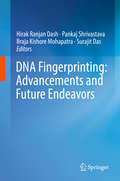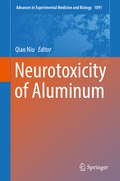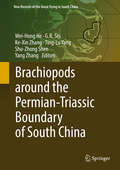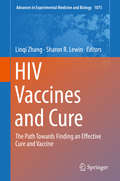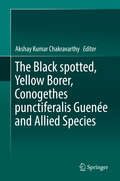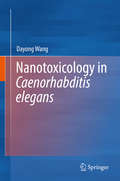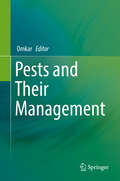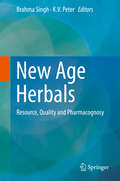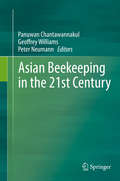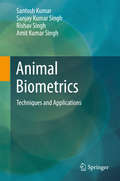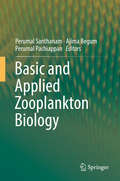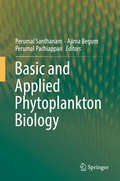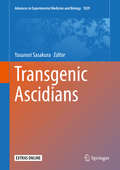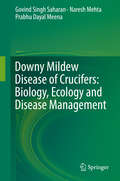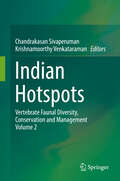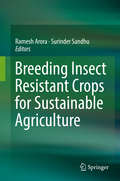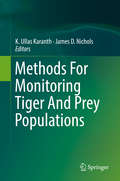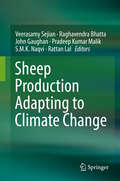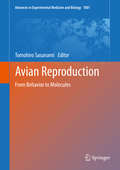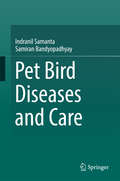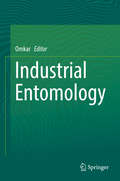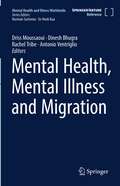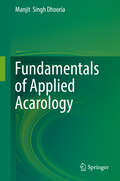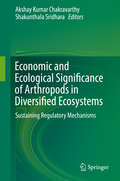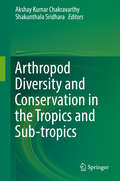- Table View
- List View
DNA Fingerprinting: Advancements and Future Endeavors
by Hirak Ranjan Dash Pankaj Shrivastava Braja Kishore Mohapatra Surajit DasThis book describes the basics and various applications of DNA fingerprinting, including in actual case studies. The book is divided in four modules; Module 1: Basics of DNA Fingerprinting, Module 2: Applications of DNA Fingerprinting, Module 3: DNA Fingerprinting: Case Studies, and Module 4: Future of DNA Fingerprinting. Each module consists of 4 to 5 chapters, written by reputed researchers, academics and forensic scientists from around the globe. The respective chapters cover e.g. related fields, the tools and techniques used, various genotyping kits, real-world case studies, ancient DNA and wild life forensics, molecular diagnosis of human diseases, legal aspects, microbial forensics and the economics of the DNA fingerprinting technique. The book offers a practical guide for professionals, graduate and post-graduate students in the fields of Forensic Science, Medicine, Genetics, Anthropology, Microbiology, and Zoology. It also serves as a useful reference resource, summarizing major technological advances in the field of DNA fingerprinting, the problems faced in this field of science and possible new solutions to these problems. Presently, DNA fingerprinting is utilized in solving the majority of criminal cases; as such, the book is also helpful for investigating agencies, as it includes representative case studies.
Neurotoxicity of Aluminum (Advances in Experimental Medicine and Biology #1091)
by Qiao NiuThis book reviews the scientific literature and the authors’ own research linking aluminum neurotoxicity with cognitive impairment and Alzheimer’s disease (AD). It focuses on aluminum levels in the brain, region-specific and subcellular distribution, and its relation to neurofibrillary tangles and amyloid beta. Further, the book stresses the importance of aluminum’s complex speciation chemistry in relation to biology, and details aluminum’s mechanism in oxidative stress and cell death, especially in connection with apoptosis and necroptosis. The electrophysiological variation and synaptic plasticity induced by aluminum are covered, while the metal’s debatable role in AD and the cross-talk between aluminum and genetic susceptibility are also discussed. In closing, the book reviews the neurotoxic effects of aluminum and its important role in the pathogenesis of AD. Given its depth of coverage, the book provides readers with a systematic summary of aluminum neurotoxicity.
Brachiopods around the Permian-Triassic Boundary of South China (New Records Of The Great Dying In South China Ser.)
by Wei-Hong He G. R. Shi Ke-Xin Zhang Ting-Lu Yang Shu-Zhong Shen Yang ZhangHIV Vaccines and Cure: The Path Towards Finding an Effective Cure and Vaccine (Advances in Experimental Medicine and Biology #1075)
by Linqi Zhang Sharon R. LewinThis book provides a comprehensive review of the major barriers to HIV cure and vaccine. It covers the fundamental virology and immunology leading to HIV transmission, protection from infection and long term HIV persistence on antiretroviral therapy. In addition, strategies being tested to eliminate persistent HIV and the rational design of vaccines to induce protective immunity are covered. This book also discusses the challenges related to the design of clinical trials for testing the safety and efficacy of these innovative approaches. This book will provide a systematic overview and also discuss controversial issues for researchers in virology and immunology, as well as practicing physicians, and scientists in the pharmaceutical industry.
The Black spotted, Yellow Borer, Conogethes punctiferalis Guenée and Allied Species
by Akshay Kumar ChakravarthyConogethes is a group of moths distributed in Austral-Asian region from India to New Guinea, the Solomon Islands and Australia.The moths are also found in Hawaii and Great Britain. Conogethes is mostly known for the economic impact of its larvae on agricultural crops. Substantial research has been undertaken in order to understand the biology of these harmful insects and to develop strategies to confine their impact. Research on chemical communication between males and females via sex pheromones is in progress.Recent research has also focused on the acoustic communication of Conogethes. The moths can feed on more than 200 plants in diversified habitats. The borer moths have become major pest on Horticultural , Agricultural,Avenue trees and forest trees. Its a pest of Quarantine importance as it has been found in Exportable commodities. The book contains 22 chapters from a dozen countries. The authors are from China, Vietnam, Australia, Sri Lanka, Malaysia, Norway etc. This is the first book on the pest globally where interesting insights are provided. This is one of the book of its kind on single pest dealing with almost all aspects of its biology and management on cultivated crops.
Nanotoxicology in Caenorhabditis elegans
by Dayong WangThis book focuses on the toxicity of engineered nanomaterials (ENMs) and their underlying physicochemical, cellular, physiological, and molecular mechanisms. Further, it covers ENMs’ translocation and their targeted organ toxicology, and discusses chemical and pharmacological strategies used to combat nanotoxicity. Engineered nanomaterials (ENMs) are defined as materials with one or more dimensions of less than 100 nm, and have shown considerable promise in several areas of development. At the same time, the potential toxicity of ENMs for human health and environmental organisms is increasingly attracting attention. In addition to the typical properties of model animals, Caenorhabditis elegans is extremely sensitive to environmental toxicants, which makes it the ideal in vivo assay system for toxicological studies. C. elegans has been widely used in toxicity assessment and toxicological studies of environmental toxicants and stresses. This book provides a comprehensive summary of nanotoxicology research on C. elegans.
Pests and Their Management
by OmkarThis book comprehensively compiles information on some of the major pests that afflict agricultural, horticultural and medicinal crops in particular as well as many polyphagous pests. Not only does this book deal with the pests of common globally produced crops it also addresses those of rarely dealt with crops such as seed spices, medicinal and aromatic plants. While the perspective of insect pests is largely Indian and South East Asian in context, the book does deal with globally problematic pests, particularly polyphagous ones. Not only will the readers be acquainted with the pests, their damaging potential and their life cycle but also with the latest methods of managements including ecofriendly measures being employed to keep pest populations at manageable levels. The 27 chapters in the book, are grouped into four sections primarily based on crop types, viz. pest of agricultural, horticultural and medicinal crops, and polyphagous pests, making the book easy to navigate. Each of the chapters is comprehensive and well illustrated and written by academicians who have dedicated their entire lives to the study of a particular crop-pest complex. The final chapter of this book provides an overview on the principles and processes of pest management.
New Age Herbals: Resource, Quality And Pharmacognosy
by Brahma Singh K. V. PeterImportance of herbs (medicinal plants) can hardly be overemphasized. They are exploited for manyfold applications, ranging from phytopharmaceuticals, to nutraceuticals, to cosmetics and many others. Keeping in view the richness of herbs and their vast potential, this book collates the most up-to-date knowledge of important herbs and herbals. The book also gives an overview of some issues causing hindrance in the promotion of herbals. This book attempts to compile the rich experience of experts working on various herbs. New age single plant species, having multiple medicinal traits worth exploiting i.e. Hippophae rhamnoides (seabuckthorn), and Morinda citrifolia (noni) also find place as full chapters in the book.
Asian Beekeeping in the 21st Century
by Geoffrey Williams Peter Neumann Panuwan ChantawannakulFrom the perspective of local scientists, this book provides insight into bees and beemanagement of Asia, with a special focus on honey bees.Asia is home to at least nine honey bee species, including the introduced European honeybee, Apis mellifera. Although A. mellifera and the native Asian honey bee, Apis cerana,are the most commonly employed species for commercial beekeeping, the remainingnon-managed native honey bee species have important ecological and economic roleson the continent. Species distributions of most honey bee species overlap in SoutheastAsia, thus promoting the potential for interspecies transmission of pests and parasites,as well as their spread to other parts of the world by human translocation.Losses of managed A. mellifera colonies is of great concern around the world, includingin Asia. Such global colony losses are believed to be caused, in part, by pests andparasites originating from Asia such as the mite Varroa destructor, the microsporidianNosema ceranae, and several bee viruses.Taking advantage of the experience of leading regional bee researchers, this book providesinsight into the current situation of bees and bee management in Asia. Recentintroductions of honey bee parasites of Asian origin to other parts of the world ensuresthat the contents of this book are broadly relevant to bee scientists, researchers, governmentoffi cials, and the general public around the world.
Animal Biometrics: Techniques And Applications
by Santosh Kumar Amit Kumar Singh Sanjay Kumar Singh Rishav SinghThis book presents state-of-the-art methodologies and a comprehensive introduction to the recognition and representation of species and individual animals based on their physiological and phenotypic appearances, biometric characteristics, and morphological image patterns. It provides in-depth coverage of this emerging area, with an emphasis on the design and analysis techniques used in visual animal biometrics-based recognition systems. <P><P>The book offers a comprehensive introduction to visual animal biometrics, addressing a range of recent advances and practices like sensing, feature extraction, feature selection and representation, matching, indexing of feature sets, and animal biometrics-based multimodal systems. It provides authoritative information on all the major concepts, as well as highly specific topics, e.g. the identification of cattle based on their muzzle point image pattern and face images to prevent false insurance claims, or the monitoring and registration of animals based on their biometric features. <P>As such, the book provides a sound platform for understanding the Visual Animal Biometrics paradigm, a vital catalyst for researchers in the field, and a valuable guide for professionals. In addition, it can help both private and public organizations adapt and enhance their classical animal recognition systems.
Basic and Applied Zooplankton Biology
by Perumal Santhanam Ajima Begum Perumal PachiappanThe coastal and ocean ecosystem is a significant feature of our planet and provides a source of food for much of life on Earth. Millions of species have been, and are still being discovered in the world’s oceans. Among these zooplankton serve as secondary producers and are significant as they form pelagic food links and act as indicators of water masses. They constitute the largest and most reliable source of protein for most of the ocean’s fishes. As such, their absence or depletion often affects fishery. In many countries, the decline in fishery has been attributed to reduced plankton populations. Furthermore, trillions of tiny copepods produce countless faecal pellets contributing greatly to the marine snow and therefore accelerating the flow of nutrients and minerals from the surface waters to the seabed. They are phylogenetically highly successful groups in terms of phylogenetic age, number of living species and success of adaptive radiation. A study of the basic and applied aspects of zooplankton would provide an index of the fishery potential and applications, offering insights into ocean ecology to safeguard food supplies and livelihoods of the millions of people living in coastal areas. For this reason, we need to understand all the facets of zooplankton as well as their interactions with atmosphere and other life forms, including human. In this context, this book discusses the basic and applied aspects of zooplankton, especially taxonomy, mosquitocidal activity, culture, analysis of nutritional, pigments and enzyme profile, preservation of copepods eggs, bioenrichment of zooplankton and application of zooplankton in sustainable aquaculture production, focusing on novel biofloc-copefloc technologies, and the impact of acidification and microplastics on zooplankton.Offering a comprehensive overview of the current issues and developments in the field of environmental and commercial applications, this book is a valuable resource for researchers, aquaculturists, environmental mangers wanting to understand the importance of zooplankton and develop technologies for the sustainable production of fish and other commodities to provide food and livelihoods for mankind.
Basic and Applied Phytoplankton Biology
by Perumal Santhanam Ajima Begum Perumal PachiappanThis book presents the latest developments and recent research trends in the field of plankton, highlighting the potential ecological and biotechnological applications. It critically and comprehensively discusses strain selection, growth characteristics, large-scale culturing, and biomass harvesting, focusing on the screening and production of high-value products from algae, and evaluating carbon dioxide sequestration from fuel gas as a climate change mitigation strategy. The latter areas of research are clearly central to the sustainable development approach that is currently attracting global attention.Over the decades, much of the literature on has focused on the biological and ecological aspects of phytoplankton found in freshwater, marine and brackish water environments. However, these organisms are known to also inhabit various other environments. More recently, there has been a substantial shift toward the concept of sustainable development and the “green economy” with emphasis on exploiting biological systems for the benefit of mankind. The significance of these plankton cannot be underestimated as they contribute approximately 40% of the oxygen in the atmosphere. Therefore, there is potential for exploitation of this invaluable biomass source that could lead to significant environmental and economic benefits for man.Providing a comprehensive outline of the most recent developments and advances in the field of industrial applications of these plankton, this book is an excellent reference resource for researchers and practitioners.
Transgenic Ascidians (Advances In Experimental Medicine And Biology #1029)
by Yasunori SasakuraThis book comprehensively describes the transgenesis techniques and applied experimental methods in ascidians including enthusiastically developed original devices in addition to concrete examples of developmental biology studies. Ascidians have been one of the most important model animals in developmental biology for studying molecular and cellular processes underlying formation of the chordate body plan. Transgenic techniques such as microinjection, electropolation, cis-element analysis and application, and TALENs and CRISPR/Cas9 have been developed in ascidians for more than 20 years, and now many applied methods, some of which are unique in ascidians, have been accumulated. Those extensive technological innovations, such as cell isolation, cell labeling, germ-line transformation, marker transgenic lines, and the experimental systems for studying notochord formation and nervous system, are exceptional particularly in marine invertebrates. This book is useful for ascidian researchers to quickly access the techniques in which they are interested as well as to compare each technology to become familiar with specialized tips, and for biologists of other organisms to learn the unique techniques and ingenious attempts specific to ascidians. Providing detailed and easily understandable descriptions of techniques, the book will inspire ascidian specialists to improve their techniques, encourage anyone wanting to begin studying ascidians, and enable readers to immediately apply the techniques to the organisms they research.
Downy Mildew Disease of Crucifers: Biology, Ecology and Disease Management
by Govind Singh Saharan Naresh Mehta Prabhu Dayal MeenaThe book reviews key developments in downy mildew research, including the disease, its distribution, symptomatology, host range, yield losses, and disease assessment; the pathogen, its taxonomy, morphology, phylogeny, variability, sporulation, survival and perpetuation, spore germination, infection, pathogenesis, seed infection, disease cycle, epidemiology, forecasting, and fine structures. The book also elaborates the mechanisms of host resistance (biochemical, histological, genetic, and molecular, including cloning and the mapping of R-genes), disease resistance breeding strategies, and the genetics of host-parasite interactions. It explores disease management based on cultural, chemical, biological, host resistance, and integrated approaches; and provides suggestions for future research areas. This book offers a comprehensive guide to an economically important disease, reviewing in detail the extant body of literature. Divided into 16 chapters, each of which includes a wealth of photographs, graphs, histograms, tables, figures, flow charts, micrographs etc., it represents an invaluable source of information for all researchers, teachers, students, industrialists, farmers, policymakers, and all others who are interested in growing healthy and profitable cruciferous crops all over the world.
Indian Hotspots: Vertebrate Faunal Diversity, Conservation And Management Volume 2
by Krishnamoorthy Venkataraman Chandrakasan SivaperumanThis book offers a comprehensive account of India’s four biodiversity hotspots: the Himalaya, Indo-Burma, Western Ghats and Sri Lanka and Andaman and Nicobar Islands. With a focus on tropical rainforests, it includes more than 30 chapters covering different vertebrate fauna e.g. fishes, amphibians, reptiles, birds, and mammals, as well as topics such as conservation and management aspects.Written by experts in the field of biodiversity conservation and management, it offers ample new insights into a number of subjects related to the faunal communities of tropical forest ecosystems, providing a valuable resource for conservationists and researchers in the field of flora and fauna diversity.
Breeding Insect Resistant Crops for Sustainable Agriculture
by Ramesh Arora Surinder SandhuThis book reviews and synthesizes the recent advances in exploiting host plant resistance to insects, highlighting the role of molecular techniques in breeding insect resistant crops. It also provides an overview of the fascinating field of insect-plant relationships, which is fundamental to the study of host-plant resistance to insects. Further, it discusses the conventional and molecular techniques utilized/useful in breeding for resistance to insect-pests including back-cross breeding, modified population improvement methods for insect resistance, marker-assisted backcrossing to expedite the breeding process, identification and validation of new insect-resistance genes and their potential for utilization, genomics, metabolomics, transgenesis and RNAi. Lastly, it analyzes the successes, limitations and prospects for the development of insect-resistant cultivars of rice, maize, sorghum and millet, cotton, rapeseed, legumes and fruit crops, and highlights strategies for management of insect biotypes that limit the success and durability of insect-resistant cultivators in the field. Arthropod pests act as major constraints in the agro-ecosystem. It has been estimated that arthropod pests may be destroying around one-fifth of the global agricultural production/potential production every year. Further, the losses are considerably higher in the developing tropics of Asia and Africa, which are already battling severe food shortage. Integrated pest management (IPM) has emerged as the dominant paradigm for minimizing damage by the insects and non-insect pests over the last 50 years. Pest resistant cultivars represent one of the most environmentally benign, economically viable and ecologically sustainable options for utilization in IPM programs. Hundreds of insect-resistant cultivars of rice, wheat, maize, sorghum, cotton, sugarcane and other crops have been developed worldwide and are extensively grown for increasing and/or stabilizing crop productivity. The annual economic value of arthropod resistance genes developed in global agriculture has been estimated to be greater than US$ 2 billion Despite the impressive achievements and even greater potential in minimizing pest- related losses, only a handful of books have been published on the topic of host-plant resistance to insects. This book fills this wide gap in the literature on breeding insect- resistant crops. It is aimed at plant breeders, entomologists, plant biotechnologists and IPM experts, as well as those working on sustainable agriculture and food security.
Methods For Monitoring Tiger And Prey Populations
by K. Ullas Karanth James D. NicholsThis book addresses issues of monitoring populations of tigers, ungulate prey species and habitat occupancy, with relevance to similar assessments of large mammal species and general biodiversity. It covers issues of rigorous sampling, modeling, estimation and adaptive management of animal populations using cutting-edge tools, such as camera-traps, genetic identification and Geographic Information Systems (GIS), applied under the modern statistical approach of Bayesian and likelihood-based inference. Of special focus here are animal survey data derived for use under spatial capture-recapture, occupancy, distance sampling, mixture-modeling and connectivity analysees. Because tigers are an icons of global conservation, in last five decades,enormous amounts of commitment and resources have been invested by tiger range countries and the conservation community for saving wild tigers. However, status of the big cat remains precarious. Rigorous monitoring of surviving wild tiger populations continues to be essential for both understanding and recovering wild tigers. However, many tiger monitoring programs lack the necessary rigor to generate the reliable results. While the deployment of technologies, analyses, computing power and human-resource investments in tiger monitoring have greatly progressed in the last couple of decades, a full comprehension of their correct deployment has not kept pace in practice. In this volume, Dr. Ullas Karanth and Dr. James Nichols, world leaders in tiger biology and quantitative ecology, respectively, address this key challenge. The have collaborated with an extraordinary array of 30 scientists with expertise in a range of necessary disciplines - biology and ecology of tigers, prey and habitats; advanced statistical theory and practice; computation and programming; practical field-sampling methods that employ technologies as varied as camera traps, genetic analyses and geographic information systems. The book is a 'tour de force' of cutting-edge methodologies for assessing not just tigers but also other predators and their prey. The 14 chapters here are lucidly presented in a coherent sequence to provide tiger-specific answers to fundamental questions in animal population assessment: why monitor, what to monitor and how to monitor. While highlighting robust methods, the authors also clearly point out those that are in use, but unreliable. The managerial dimension of tiger conservation described here, the task of matching monitoring objectives with skills and resources to integrate tiger conservation under an adaptive framework, also renders this volume useful to wildlife scientists as well as conservationists.
Sheep Production Adapting to Climate Change
by Veerasamy Sejian Raghavendra Bhatta John Gaughan Pradeep Kumar Malik S. M. K. Naqvi Rattan LalThis book presents a compilation of the latest findings from reputed researchers around the globe, covering in detail climate change and its effects on sheep production. In the current global climate change scenario, information related to its impact on livestock agriculture is lacking. The negative impacts of climate change are already being felt by all livestock species. Further, the mitigation and amelioration strategies that are applicable for one species may not hold true for another. As such, concerted research efforts are needed to identify species-specific strategies for mitigation and adaptation. With that goal in mind, this book is the first of its kind to gather comprehensive information pertaining to the impact of climate change on various aspects of sheep production. It also sheds light on the role of sheep with regard to the global greenhouse gas pool. The book highlights the status quo of sheep production from climate change perspectives and projects the significance of adapting future sheep production to the challenges posed by climate change. It addresses in detail the various adaptations, methane mitigation and amelioration strategies needed to sustain sheep production in the future. In addition, the book presents development plans and policies that will allow the sheep industry to cope with current climate changes and strategies that will lessen future impacts. Bringing together essential information prepared by world-class researchers hailing from different agro-ecological zones, this book offers a unique resource for all researchers, teachers and students associated with sustaining the sheep production in the face of global change.
Avian Reproduction: From Behavior to Molecules (Advances in Experimental Medicine and Biology #1001)
by Tomohiro SasanamiThis book provides everything from basic knowledge to the recent understandings of avian reproductive physiology, covering many unique aspects. It will inspire avian biologists as well as researchers in varied fields and will offer important steps towards better fertilization success in birds. In spite of the recent remarkable developments in modern technology, a comprehensive understanding of the reproductive mechanisms is still far in the future due to the diverse reproductive tactics in vertebrates. Birds have highly refined reproductive strategies and some of those strategies are unique to birds. However, together with ongoing progress of the genome analysis of birds and the crying need for further increase in meat and egg production, research on avian reproduction is now accelerating and becoming more important. With contributions by leading scientists, the book explains avian primordial germ cells; the sex-determining mechanism; reproductive endocrinology and immunology; sperm, egg, and egg coat; sperm-egg interaction; polyspermic fertilization; seasonal reproduction; social triggers; hormonal and behavioral changes; broodiness; oviductal sperm storage; and biotechnology. This book is recommended for all researchers and students who are interested in birds or reproduction.
Pet bird diseases and care
by Indranil Samanta Samiran BandyopadhyayThis book provides fundamental information on pet birds, menaces, and advances made in the diagnosis and treatment of menaces. It is the only book covering all species of pet birds, menaces and their individual management. The handful of related books available worldwide are largely outdated and focus on a single species or breed of pet bird. The book encompasses the history of bird keeping, common breeds of birds, their nutritional requirements, list of zoonotic diseases transmitted by birds and guideline for their prevention. It covers infectious, non-infectious clinical and metabolic diseases, and toxicity in detail with a special focus on the history of diseases, etiology, affected hosts, pathogenesis, clinical signs, diagnosis and treatment. Separate chapters detail relevant diagnostic techniques, management and care practices, including updated information. The book offers an invaluable guide for students and teachers in the field of (avian) veterinary medicine, scientists/research scholars working in related fields, and avian medicine practitioners, as well as all those progressive bird owners who want to know the basics of their care and management.
Industrial Entomology
by OmkarThis book is a compilation of writings focused on conventional and unconventional insect products. Some of these products are commercials successes, while others are waiting to be launched and are the potential produce of the future. In addition to the well known products honey, mulberry silk, and lac, the book primarily concentrates on silk producing insects other than the mulberry silkworm, insects as food, as sources of medicines, pest and weed managers, and as pollinators. The book highlights the all pervasive role of insects in improving human lives at multiple levels. Accordingly, while most books on insects concentrate on how to limit growth in their population, it instead focuses on how to propagate them. In each chapter, the book brings to the fore how insects are far more beneficial to us than their well publicised harmful roles. This book approaches both unconventional and conventional insect products, such as honey, silk and lac in much more depth than the available literature. It investigates different aspects of the production of these insects, such as the related processes, problems and utilities, in dedicated chapters. Because this book deals with the production of insects or their produce, it has been named Industrial Entomology, perhaps the only book that truly reveals the tremendous potential of insects to help humans live better lives. Based on the research and working experience of the contributors, who are global experts in their respective fields, it provides authentic, authoritative and updated information on these topics. The book offers a unique guide for students, teachers, policy planners, small scale industrialists, and government ministries of agriculture and industry across the globe. It will provide a much required stimulus to insect appreciation and generate enthusiasm for research and the broader acceptance for insect produce. Hopefully, it will also present the Indian perspective on these topics to a global readership.
Mental Health, Mental Illness and Migration (Mental Health and Illness Worldwide)
by Dinesh Bhugra Driss Moussaoui Rachel Tribe Antonio V. VentriglioThis book unravels the mental health challenges of the migrants and the socio economic and cultural conditions that bear on the mental well being. In addition, it covers the measures of intervention that can help the migrants maintain or restore their mental well being. Research included in the book is timely given that there is ever increasing mobility of people which on one hand has led to better livelihoods, but on the other has created conditions of stress for the migrants and their families. As migrants are often found to be hesitant of using the health care facilities in the new place which may be due to the lack of awareness, this book elaborates on the health care facilities, cost issues, stigma, and several other factors.
Fundamentals of Applied Acarology
by Manjit Singh DhooriaAcarology - the study of mites and ticks, is a subdiscipline of Zoology, and is many times considered in the field of Entomology (the study of insects). Mites and ticks are distributed throughout the world and inhabit almost every ecosystem (both terrestrial and aquatic) including grassland soils. More than 55,000 species of mites and ticks are already described. Mites and ticks directly affects humans as pests of different crops, fruit plants, vegetable crops and field crops; as parasites of human beings, veterinary animals, poultry and pets; pests of stored grains and other products; mushrooms and cheese; and as parasites of honeybees. Mite infestations are responsible for economic losses worth billions of dollars in terms of reduced crop yields and lowered quality of produce. Many species of mites serve as vectors of various plant diseases; some species of ticks cause losses through blood feeding and by transmitting many diseases among man and animals. House-dust mite allergies, and tick bite allergies are also common in many parts of the world. Present Book, "Fundamentals of Applied Acarology," is written keeping in view non-availability of any standard text dealing in different aspects of acarology at one place. Separate chapters in this book are devoted to Importance of Acarology, Historical account, acarine technology, morphology and anatomy of Acari; Feeding, Development and Reproduction. Molecular developments in relation to mites and ticks are also discussed. Role of mites and ticks in Quarantines of plants and animals; forensic/criminal investigations; and importance of accidental acarophagy are discussed in detail. Safe usage of pesticides based on their mode of action (IRAC's Groups), development of acaricide resistance and measures to mitigate it are discussed. Mite pests of fruit trees, vegetable plants, and floricultural plants; field crops; mite problems in greenhouses/polyhouses; and mite problems encountered under organic cultivation of plants; and their management through minimum usage of pesticides are emphasized. Role of different predaceous mites in controlling plant pests like thrips, aphids and scale insects is elaborately discussed. Biological control of phytophagous mites is discussed in detail. Different animal parasitic mites and ticks are discussed from veterinary and medical point of view. At the end of each chapter, many important references for further reading; and Electronic References (ER) in the form of youtube links and other weblinks are given to understand fully how these tiny creatures look like; behave, feed and reproduce; nature of damage they cause to plants and animals; and measures to mitigate them. Weblinks will stimulate interest in the readers for more information about different mites and ticks. The knowledge contained in the book may prove as best material for "General and Applied Acarology" course for graduate and post-graduate levels, teachers and researchers in entomology, pest control advisors, professional entomologists, pesticide industry managers, policy planners, and others having interest in mites and ticks.
Economic and Ecological Significance of Arthropods in Diversified Ecosystems
by Akshay Kumar Chakravarthy Shakunthala SridharaArthropods are invertebrates that constitute over 90% of the animal kingdom, and their bio-ecology is closely linked with global functioning and survival. Arthropods play an important role in maintaining the health of ecosystems, provide livelihoods and nutrition to human communities, and are important indicators of environmental change. Yet the population trends of several arthropods species show them to be in decline. Arthropods constitute a dominant group with 1. 2 million species influencing earth's biodiversity. Among arthropods, insects are predominant, with ca. 1 million species and having evolved some 350 million years ago. Arthropods are closely associated with living and non-living entities alike, making the ecosystem services they provide crucially important. In order to be effective, plans for the conservation of arthropods and ecosystems should include a mixture of strategies like protecting key habitats and genomic studies to formulate relevant policies for in situ and ex situ conservation. This two-volume book focuses on capturing the essentials of arthropod inventories, biology, and conservation. Further, it seeks to identify the mechanisms by which arthropod populations can be sustained in terrestrial and aquatic ecosystems, and by means of which certain problematic species be managed without producing harmful environmental side-effects. This edited compilation includes chapters contributed by over 80 biologists on a wide range of topics embracing the diversity, distribution, utility and conservation of arthropods and select groups of insect taxa. More importantly, it describes in detail the mechanisms of sustaining arthropod ecosystems, services and populations. It addresses the contribution of modern biological tools such as molecular and genetic techniques regulating gene expression, as well as conventional, indigenous practices in arthropod conservation. The contributors reiterate the importance of documenting and understanding the biology of arthropods from a holistic perspective before addressing conservation issues at large. This book offers a valuable resource for all zoologists, entomologists, ecologists, conservation biologists, policy makers, teachers and students interested in the conservation of biological resources.
Arthropod Diversity and Conservation in the Tropics and Sub-tropics
by Akshay Kumar Chakravarthy Shakunthala SridharaArthropods are invertebrates that constitute over 90% of the animal kingdom, and their bio-ecology is closely linked with global functioning and survival. Arthropods play an important role in maintaining the health of ecosystems, provide livelihoods and nutrition to human communities, and are important indicators of environmental change. Yet the population trends of several arthropods species show them to be in decline. Arthropods constitute a dominant group with 1. 2 million species influencing earth's biodiversity. Among arthropods, insects are predominant, with ca. 1 million species and having evolved some 350 million years ago. Arthropods are closely associated with living and non-living entities alike, making the ecosystem services they provide crucially important. In order to be effective, plans for the conservation of arthropods and ecosystems should include a mixture of strategies like protecting key habitats and genomic studies to formulate relevant policies for in situ and ex situ conservation. This two-volume book focuses on capturing the essentials of arthropod inventories, biology, and conservation. Further, it seeks to identify the mechanisms by which arthropod populations can be sustained in terrestrial and aquatic ecosystems, and by means of which certain problematic species be managed without producing harmful environmental side-effects. This edited compilation includes chapters contributed by over 80 biologists on a wide range of topics embracing the diversity, distribution, utility and conservation of arthropods and select groups of insect taxa. More importantly, it describes in detail the mechanisms of sustaining arthropod ecosystems, services and populations. It addresses the contribution of modern biological tools such as molecular and genetic techniques regulating gene expression, as well as conventional, indigenous practices in arthropod conservation. The contributors reiterate the importance of documenting and understanding the biology of arthropods from a holistic perspective before addressing conservation issues at large. This book offers a valuable resource for all zoologists, entomologists, ecologists, conservation biologists, policy makers, teachers and students interested in the conservation of biological resources.
